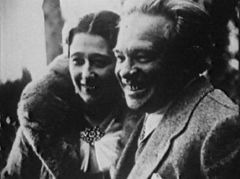 During the Middle Ages, the Italian peninsula was home to a collection of smaller independent city-states and kingdoms. Only in 1861 did Italian nationalists and monarchists create a unified Kingdom of Italy. Characterized by severe economic hardship, particularly found in the agricultural southern region, this political unification saw mass emigrations that forced Italians to settle in different parts of the world. The political instability and turbulence experienced during and after World War 1, forced Italians once more to scrutinize and examine the foundations of their national identity.
During the Middle Ages, the Italian peninsula was home to a collection of smaller independent city-states and kingdoms. Only in 1861 did Italian nationalists and monarchists create a unified Kingdom of Italy. Characterized by severe economic hardship, particularly found in the agricultural southern region, this political unification saw mass emigrations that forced Italians to settle in different parts of the world. The political instability and turbulence experienced during and after World War 1, forced Italians once more to scrutinize and examine the foundations of their national identity.
For Ottorino Respighi (1879-1936) this identity was securely situated in the artistic expressions of the Italian Renaissance and Baroque. His historicist interest in the music of the past emerged not only in critical editions of the music of Claudio Monteverdi and Antonio Vivaldi, but also manifested itself in his own compositions. In all, Respighi orchestrated and published three collections of lute, guitar and viol music from Italy’s historical past, aptly entitled Ancient Airs and Dances.
Ottorino Respighi: Ancient Airs and Dances, Suite No. 2, P. 138
We can learn much about Ottorino Respighi’s musical convictions from an interview he gave for Musical America in 1925. “Atonality,” he said, “Thank heaven, that’s done for! The future course of music? Who can say? I believe that every composer should first of all be individual. The Italian genius is for melody and clarity.” In practical matters, Respighi tried to reconcile Italian musical traditions with the Romantic, impressionist and neo-classical streams that were fashionable in Europe. For Respighi, the inspirations for his music were found in ancient rather than in modern Italy. The Metamorphoseon of 1930 was written in response to a commission from Serge Koussevitzky for the 50th anniversary of the Boston Symphony Orchestra. Essentially a concerto for orchestra in thirteen continuous sections, this theme and variations “should not be seen as an allusion to the Middle Ages, but rather to the different ways in which the music can be transformed by different sections of the orchestra.”
Ottorino Respighi: Metaorphoseon modi XII, P. 169
 Respighi’s Suite in G major for strings and organ dates from 1905 and pays homage to a number of baroque composers, including J.S. Bach, Girolamo Frescobaldi and Arcangelo Corelli. Modeled on the style of a “Concerto Grosso,” the organ serves as the solo instrument and the strings as the ensemble. The opening “Preludio” generates an exciting forward momentum and provides lush and colorful textures and orchestration. Originally, the “Aria” was composed as a stand-alone movement in 1901, but Respighi kept reusing this highly expressive melody in a number of works. The “Pastorale” and “Cantico,” with its simple textures and embellished ornamentations use Frescobaldi as a model. As Respighi pays homage to his illustrious predecessors, he also honed his skills for orchestration and refined his sense of melody.
Respighi’s Suite in G major for strings and organ dates from 1905 and pays homage to a number of baroque composers, including J.S. Bach, Girolamo Frescobaldi and Arcangelo Corelli. Modeled on the style of a “Concerto Grosso,” the organ serves as the solo instrument and the strings as the ensemble. The opening “Preludio” generates an exciting forward momentum and provides lush and colorful textures and orchestration. Originally, the “Aria” was composed as a stand-alone movement in 1901, but Respighi kept reusing this highly expressive melody in a number of works. The “Pastorale” and “Cantico,” with its simple textures and embellished ornamentations use Frescobaldi as a model. As Respighi pays homage to his illustrious predecessors, he also honed his skills for orchestration and refined his sense of melody.
Ottorino Respighi: Suite in G Major, P. 58
For 21st century audiences, Respighi’s musical oeuvre has been narrowly channeled to focus on a select number of orchestral works. It has rather conveniently been forgotten that Respighi composed a total of 9 operas! Musical commentators and critics have suggested, “His operas are strong on orchestration but weak on the vocal parts, and based on silly and boring libretti.” Clearly, Respighi’s operas are not considered mainstream, but they are certainly not silly! La fiamma (The Flame) is based on the story of Anne Pedersdotter, a Norwegian woman accused of witchcraft and burnt at the stage in 1590. Respighi and his librettist Claudio Guastalla change the setting to 7th century Ravenna. The melodramatic tale involves the illicit love of Silvana, the daughter of a witch, for her stepson Donello. When her husband Basilio dies of a heart attack, Silvana is accused of causing his death by witchcraft and is condemned to death.
Ottorino Respighi: Fa fiamma, “Act 1”



